spare wheel CITROEN C4 PICASSO 2022 User Guide
[x] Cancel search | Manufacturer: CITROEN, Model Year: 2022, Model line: C4 PICASSO, Model: CITROEN C4 PICASSO 2022Pages: 316, PDF Size: 10.36 MB
Page 174 of 316

172
Deactivation of the system is recommended in
the following situations:
-
d
riving on a road sur face in poor condition,
-
p
oor weather conditions,
-
d
riving on slippery sur faces (ice).
Activation/Deactivation
Activation and deactivation of the system is
done in the Driving menu of the touch screen.
Select the " Driving functions " then the "Lane
assist " tab.
The system state remains in memory when the
ignition is switched off.
Malfunction
Operating limits
The system goes into standby automatically in
the following cases:
-
E
SC deactivated or operation triggered,
-
s
peed below 40 mph (65 km/h) or greater
than 112
mph (180 km/h),
-
c
onnected electrically to a
trailer,
-
u
se of the "space-saver" spare
wheel detected (as detection is not
immediate, deactivation of the system is
recommended),
-
d
ynamic driving style detected, pressure on
the brake or accelerator pedal,
-
d
riving where there are no lane markings,
-
a
ctivation of the direction indicators,
-
c
rossing the inside line on a bend,
-
d
riving in a tight corner,
-
i
nactivity by the driver detected during
correction. The following situations may interfere with
the operation of the system or prevent it
working:
-
c
onditions of poor visibility (inadequate
street lighting, snowfall, rain, fog),
-
d
azzle (headlamps of an oncoming
vehicle, low sun, reflections on a
damp
road, leaving a
tunnel, alternating
shade and light),
-
w
indscreen area located in front of the
camera: dirty, misted, frost-covered,
snow-covered, damaged or covered by
a
s t i c ke r,
-
l
ane markings worn, hidden (snow,
mud) or multiple (roadworks, etc.),
-
r
unning close to the vehicle in front
(the lane markings may not be
detected),
-
r
oads that are narrow, winding, etc.
Risk of undesirable operation
The system is not intended for driving in the
following situations:
-
d
riving on a speed circuit,
-
d
riving with a trailer,
-
d
riving on a rolling stand,
-
d
riving on unstable sur faces.
In the event of a
fault with the system, you are
alerted by the illumination of these warning
lamps in the instrument panel, accompanied by
the display of a
message and an audible signal.
Have the system checked by a
CITROËN
dealer or a
qualified workshop.
Driving
Page 193 of 316

191
Misfuel prevention (Diesel)
(Depending on the country of sale.)
Mechanical device which prevents filling the
tank of a Diesel vehicle with petrol. It helps
avoid the risk of engine damage that can result
from filling with the wrong fuel.
Operation
It remains possible to use a fuel can to fill
t he tank.
In order to ensure a
good flow of fuel,
do not place the nozzle of the fuel can in
direct contact with the flap of the misfuel
prevention device and pour slowly. Travelling abroad
As Diesel fuel pump nozzles may be
different in other countries, the presence
of the misfuel prevention device may make
refuelling impossible.
Not all Diesel vehicles are fitted with
misfuel protection, so before travelling
abroad, we recommend that you check
with the CITROËN dealer network,
whether your vehicle is suitable for the
fuel pumps in the country in which you
intend to travel.
When a petrol filler nozzle is introduced into
the fuel filler neck of a Diesel vehicle, it comes
into contact with the flap. The system remains
closed and prevents filling.
Do not persist but introduce a Diesel type
filler nozzle.
Snow chains
In wintry conditions, snow chains
improve traction as well as the
behaviour of the vehicle when
braking.
Snow chains must be fitted only to the
front wheels. They must never be fitted to
"space-saver" type spare wheels.
Take account of the legislation in force in
your country on the use of snow chains
and the maximum authorised speed.
Installation tips
F If you have to fit the chains during a journey,
stop the vehicle on a flat sur face on the side
of the road.
F
A
pply the parking brake and position any
wheel chocks under the wheels to prevent
movement of your vehicle.
F
F
it the chains following the instructions
provided by the manufacturer.
F
M
ove off gently and drive for a few
moments, without exceeding 31
mph
(50
km/h).
F
S
top your vehicle and check that the snow
chains are correctly tightened.
It is strongly recommended that before
you leave, you practise fitting the snow
chains on a
level and dry sur face.
Avoid driving with snow chains on roads
that have been cleared of snow to avoid
damaging your vehicle's tyres and the
road sur face. If your vehicle is fitted with
alloy wheels, check that no part of the
chain or its fixings is in contact with the
wheel rim.
7
Practical information
Page 205 of 316
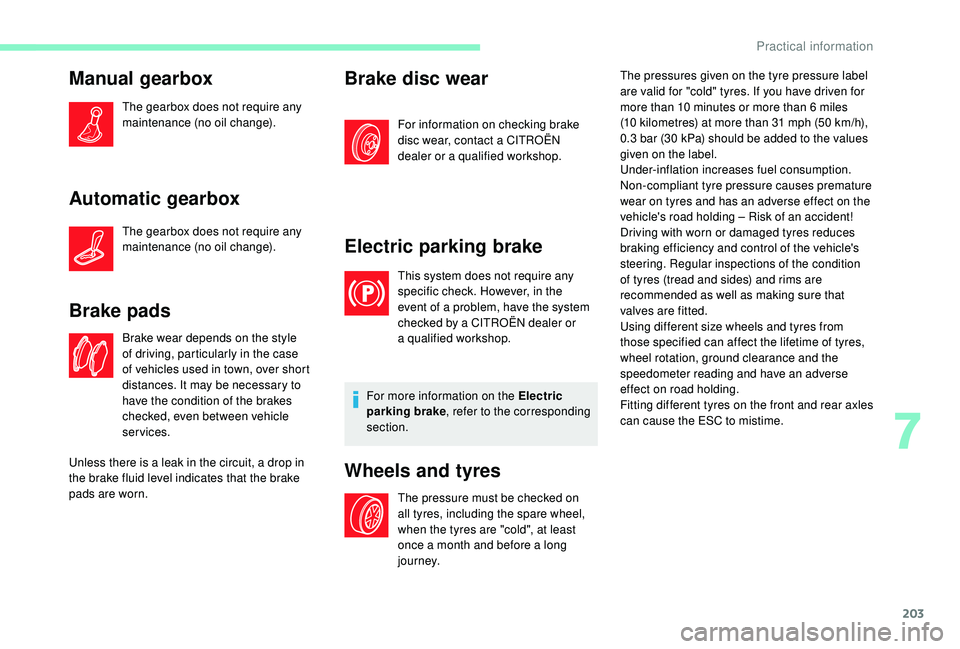
203
Manual gearbox
The gearbox does not require any
maintenance (no oil change).
Automatic gearbox
The gearbox does not require any
maintenance (no oil change).
Brake pads
Brake wear depends on the style
of driving, particularly in the case
of vehicles used in town, over short
distances. It may be necessary to
have the condition of the brakes
checked, even between vehicle
services.
Unless there is a
leak in the circuit, a drop in
the brake fluid level indicates that the brake
pads are worn.
Brake disc wear
For information on checking brake
disc wear, contact a CITROËN
dealer or a
qualified workshop.
Electric parking brake
This system does not require any
specific check. However, in the
event of a problem, have the system
checked by a
CITROËN dealer or
a
qualified workshop.
For more information on the Electric
parking brake , refer to the corresponding
section.
Wheels and tyres
The pressure must be checked on
all tyres, including the spare wheel,
when the tyres are "cold", at least
once a
month and before a long
j o u r n ey. The pressures given on the tyre pressure label
are valid for "cold" tyres. If you have driven for
more than 10
minutes or more than 6 miles
(10 kilometres) at more than 31 mph (50 km/h),
0.3 bar (30 kPa) should be added to the values
given on the label.
Under-inflation increases fuel consumption.
Non-compliant tyre pressure causes premature
wear on tyres and has an adverse effect on the
vehicle's road holding – Risk of an accident!
Driving with worn or damaged tyres reduces
braking efficiency and control of the vehicle's
steering. Regular inspections of the condition
of tyres (tread and sides) and rims are
recommended as well as making sure that
valves are fitted.
Using different size wheels and tyres from
those specified can affect the lifetime of tyres,
wheel rotation, ground clearance and the
speedometer reading and have an adverse
effect on road holding.
Fitting different tyres on the front and rear axles
can cause the ESC to mistime.
7
Practical information
Page 213 of 316
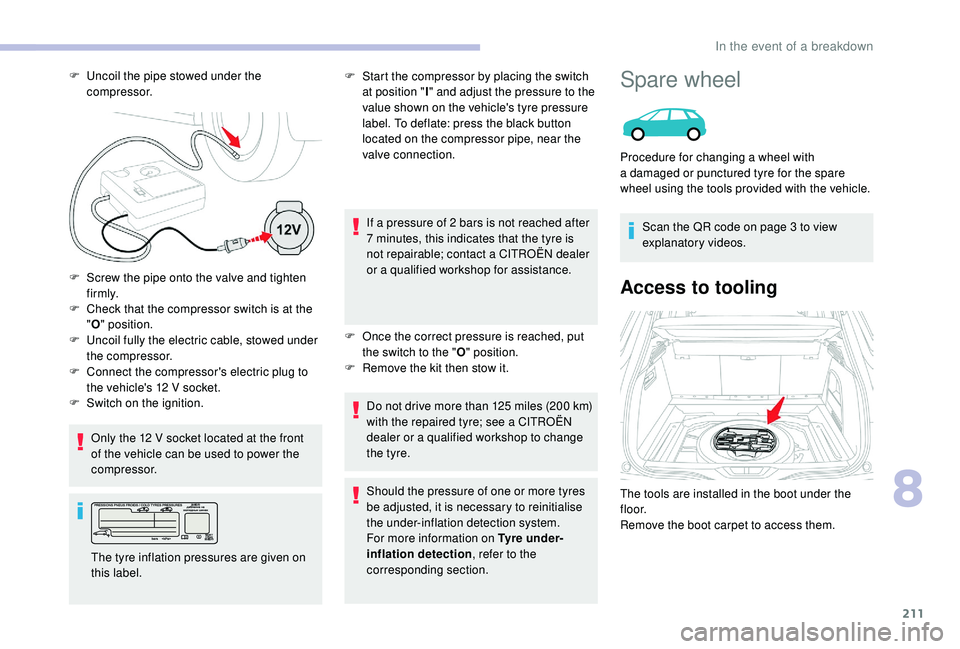
211
F Check that the compressor switch is at the "O " position.
F
U
ncoil fully the electric cable, stowed under
the compressor.
Only the 12
V socket located at the front
of the vehicle can be used to power the
compressor. F
S
tart the compressor by placing the switch
at position " I" and adjust the pressure to the
value shown on the vehicle's tyre pressure
label. To deflate: press the black button
located on the compressor pipe, near the
valve connection.
If a pressure of 2 bars is not reached after
7 minutes, this indicates that the tyre is
not repairable; contact a CITROËN dealer
or a
qualified workshop for assistance.
F
O
nce the correct pressure is reached, put
the switch to the " O" position.
F
R
emove the kit then stow it.
Do not drive more than 125
miles (200 km)
with the repaired tyre; see a
CITROËN
dealer or a
qualified workshop to change
the tyre.
Should the pressure of one or more tyres
be adjusted, it is necessary to reinitialise
the under-inflation detection system.
For more information on Tyre under-
inflation detection , refer to the
corresponding section.
F
U
ncoil the pipe stowed under the
compressor.
F
S
crew the pipe onto the valve and tighten
f i r m l y.
F
C
onnect the compressor's electric plug to
the vehicle's 12
V socket.
F
S
witch on the ignition.
The tyre inflation pressures are given on
this label.
Spare wheel
Scan the QR code on page 3 to view
e xplanatory videos.
Access to tooling
Procedure for changing a wheel with
a damaged or punctured tyre for the spare
wheel using the tools provided with the vehicle.
The tools are installed in the boot under the
f l o o r.
Remove the boot carpet to access them.
8
In the event of a breakdown
Page 214 of 316

212
List of tools
(Depending on equipment.)4.
Wheel bolt cover removal tool.
Removes the wheel bolt covers on alloy
wheels.
5. Socket for the security bolts (located in
the glove box).
For adapting the wheelbrace to the special
"security" bolts.
6. Towing eye and tool to open the front
protective cover.
1. Wheelbrace.
For removing the wheel trim and the wheel
fastening bolts.
2. Chock to immobilise the vehicle (except
versions with manual gearbox).
3. Jack with integrated handle.
Used to raise the vehicle. For more information on To w i n g
, refer to the
corresponding section.
All of these tools are specific to your
vehicle and may vary according to the
level of equipment.
Do not use them for any other purposes.
The jack must only be used to change
a wheel with a damaged or punctured tyre.
Do not use any jack other than the one
supplied with this vehicle.
If the vehicle does not have its original jack,
contact a
CITROËN dealer or a qualified
workshop to obtain the correct jack for it.
The jack meets European standards,
as defined in the Machinery Directive
2006/42/EC.
The jack does not require any
maintenance.
Access to the spare wheel
The spare wheel is located in the boot, under
t h e f l o o r.
Taking out the wheel
F Loosen the central nut.
F R emove the fastening device (nut and bolt).
F
R
aise the spare wheel towards you from the
r e a r.
F
T
ake the wheel out of the boot.
In the event of a breakdown
Page 215 of 316
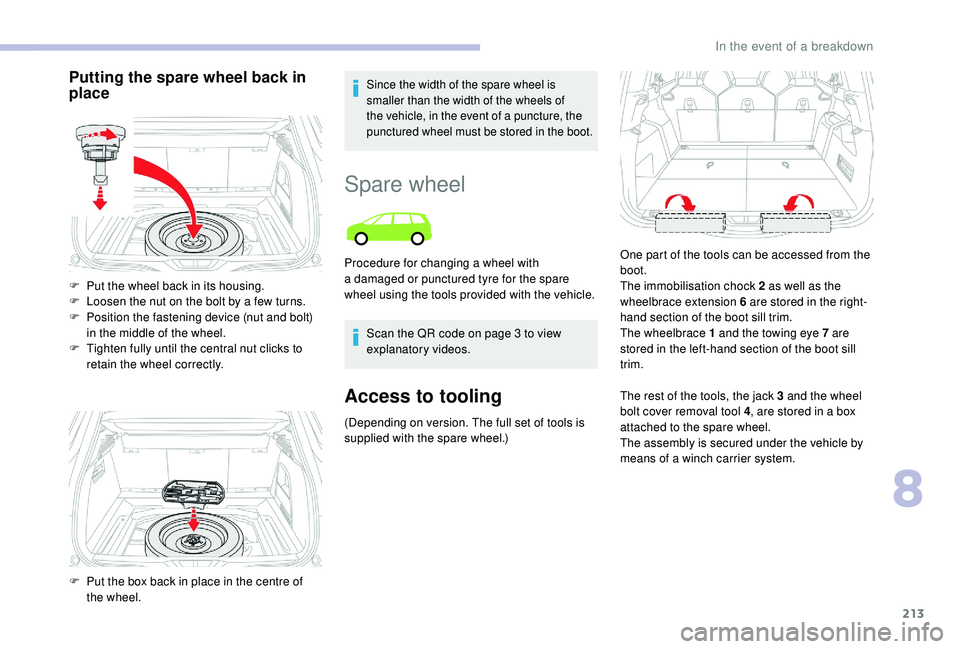
213
Putting the spare wheel back in
placeSince the width of the spare wheel is
smaller than the width of the wheels of
the vehicle, in the event of a puncture, the
punctured wheel must be stored in the boot.
F Put the wheel back in its housing.
F L oosen the nut on the bolt by a few turns.
F
P
osition the fastening device (nut and bolt)
in the middle of the wheel.
F
T
ighten fully until the central nut clicks to
retain the wheel correctly.
F
P
ut the box back in place in the centre of
the wheel.
Spare wheel
Scan the QR code on page 3 to view
e xplanatory videos.
Access to tooling
(Depending on version. The full set of tools is
supplied with the spare wheel.) The rest of the tools, the jack 3
and the wheel
bolt cover removal tool 4 , are stored in a box
attached to the spare wheel.
The assembly is secured under the vehicle by
means of a
winch carrier system.
Procedure for changing a
wheel with
a damaged or punctured tyre for the spare
wheel using the tools provided with the vehicle. One part of the tools can be accessed from the
boot.
The immobilisation chock 2 as well as the
wheelbrace extension 6 are stored in the right-
hand section of the boot sill trim.
The wheelbrace 1 and the towing eye 7 are
stored in the left-hand section of the boot sill
trim.
8
In the event of a breakdown
Page 216 of 316

214
List of tools
(Depending on version. The full set of tools is
supplied with the spare wheel.)
1.Wheelbrace.
For removing the wheel trim and removing
the wheel bolts.
2. Chock to immobilise the vehicle (except
for versions with manual gearbox).
3. Jack with integrated handle.
Used to raise the vehicle. 4.
Wheel bolt cover removal tool.
Removes the wheel bolt covers on alloy
wheels.
5. Socket for wheel security bolts (stored in
the glove box).
For adapting the wheelbrace to the special
"security" bolts.
6. Wheelbrace extension.
For slackening/tightening the spare wheel
winch cable carrier nut.
7. Towing eye and tool to open the front
protective cover.
For more information on To w i n g , refer to the
corresponding section.
All of these tools are specific to your
vehicle and may vary according to the
level of equipment.
Do not use them for any other purposes.
The jack must only be used to change
a wheel with a damaged or punctured tyre.
Do not use any jack other than the one
supplied with this vehicle.
If the vehicle does not have its original jack,
contact a
CITROËN dealer or a qualified
workshop to obtain the correct jack for it.
The jack meets European standards,
as defined in the Machinery Directive
2006/42/EC.
The jack does not require any
maintenance.
Wheel with wheel trim
When removing the wheel , first remove the
trim using the wheelbrace 1 by pulling at the
valve aperture.
When refitting the wheel , refit the trim
starting by placing its notch facing the valve
and press around its edge with the palm of your
hand.
Access to the spare wheel
(Depending on version.)
Only a "space-saver" type spare wheel
may be fixed underneath the vehicle.
The spare wheel is supported by a
winch
carrier system underneath the vehicle.
In the event of a breakdown
Page 217 of 316
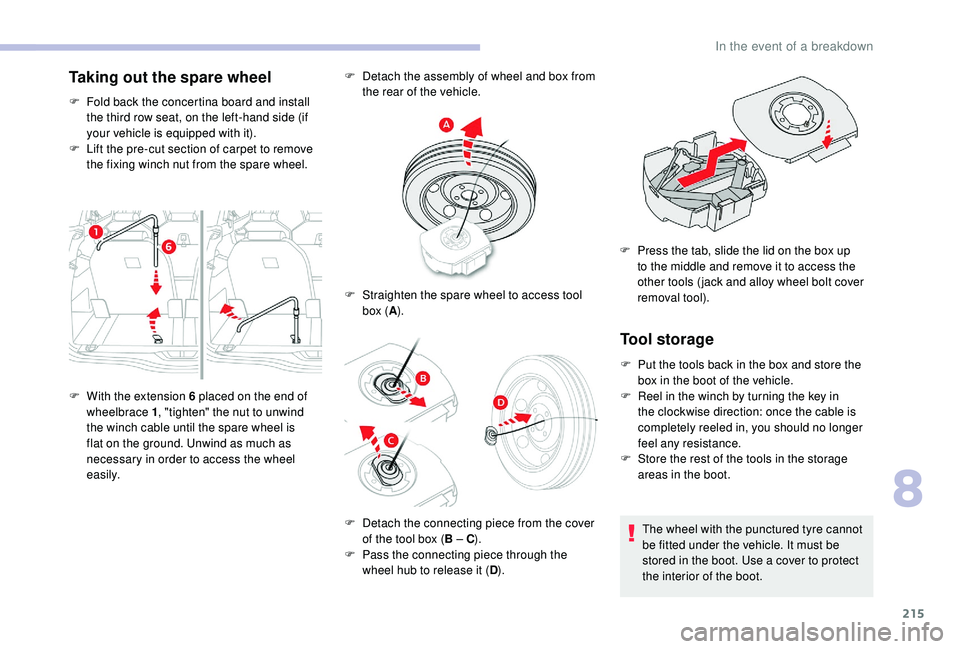
215
Taking out the spare wheel
F Fold back the concertina board and install the third row seat, on the left-hand side (if
your vehicle is equipped with it).
F
L
ift the pre-cut section of carpet to remove
the fixing winch nut from the spare wheel. F
D
etach the assembly of wheel and box from
the rear of the vehicle.
Tool storage
F Put the tools back in the box and store the box in the boot of the vehicle.
F
R
eel in the winch by turning the key in
the clockwise direction: once the cable is
completely reeled in, you should no longer
feel any resistance.
F
S
tore the rest of the tools in the storage
areas in the boot.
The wheel with the punctured tyre cannot
be fitted under the vehicle. It must be
stored in the boot. Use a
cover to protect
the interior of the boot.
F
W
ith the extension 6 placed on the end of
wheelbrace 1 , "tighten" the nut to unwind
the winch cable until the spare wheel is
flat on the ground. Unwind as much as
necessary in order to access the wheel
easily. F
S
traighten the spare wheel to access tool
box ( A).
F
D
etach the connecting piece from the cover
of the tool box ( B – C).
F
P
ass the connecting piece through the
wheel hub to release it ( D). F
P
ress the tab, slide the lid on the box up
to the middle and remove it to access the
other tools ( jack and alloy wheel bolt cover
removal tool).
8
In the event of a breakdown
Page 218 of 316
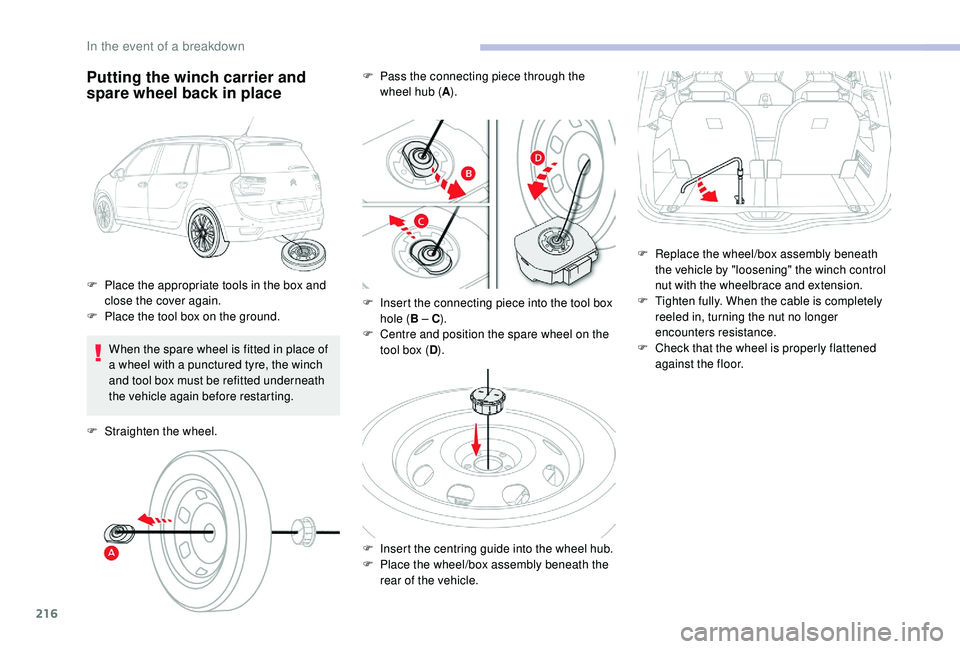
216
Putting the winch carrier and
spare wheel back in place
When the spare wheel is fitted in place of
a wheel with a punctured tyre, the winch
and tool box must be refitted underneath
the vehicle again before restarting.
F
S
traighten the wheel.
F
P
lace the appropriate tools in the box and
close the cover again.
F
P
lace the tool box on the ground. F
P
ass the connecting piece through the
wheel hub ( A).
F
I
nsert the connecting piece into the tool box
hole ( B – C).
F C entre and position the spare wheel on the
tool box ( D).
F
I
nsert the centring guide into the wheel hub.
F
P
lace the wheel/box assembly beneath the
rear of the vehicle. F
R
eplace the wheel/box assembly beneath
the vehicle by "loosening" the winch control
nut with the wheelbrace and extension.
F
T
ighten fully. When the cable is completely
reeled in, turning the nut no longer
encounters resistance.
F C heck that the wheel is properly flattened
against the floor.
In the event of a breakdown
Page 220 of 316
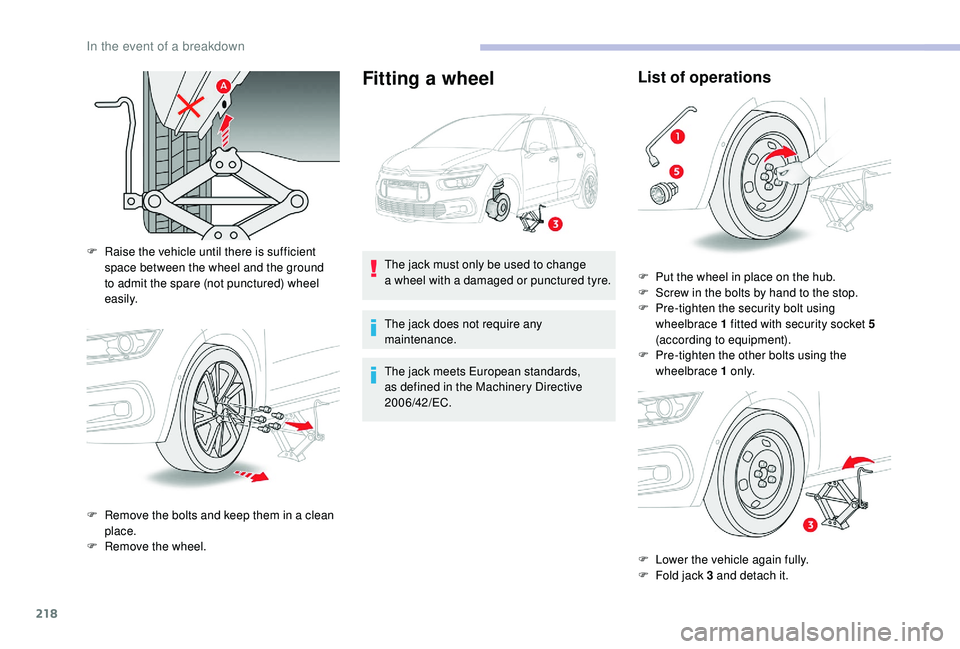
218
Fitting a wheel
F Raise the vehicle until there is sufficient
space between the wheel and the ground
to admit the spare (not punctured) wheel
easily.
F
R
emove the bolts and keep them in a clean
place.
F
R
emove the wheel. The jack must only be used to change
a
wheel with a damaged or punctured tyre.
The jack does not require any
maintenance.
The jack meets European standards,
as defined in the Machinery Directive
2006/42/EC.
List of operations
F Put the wheel in place on the hub.
F S crew in the bolts by hand to the stop.
F
P
re-tighten the security bolt using
wheelbrace 1
fitted with security socket 5
(according to equipment).
F
P
re-tighten the other bolts using the
wheelbrace 1
o n l y.
F
L
ower the vehicle again fully.
F
F
old jack 3 and detach it.
In the event of a breakdown